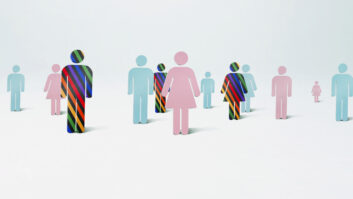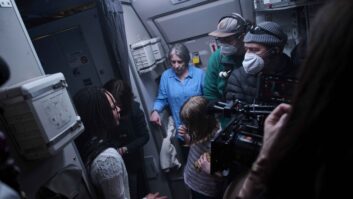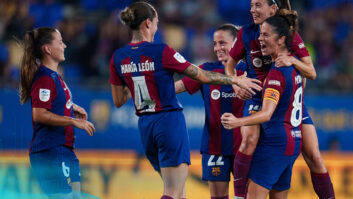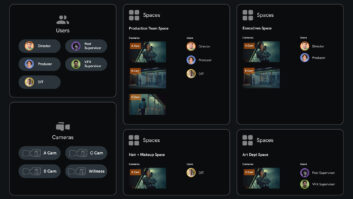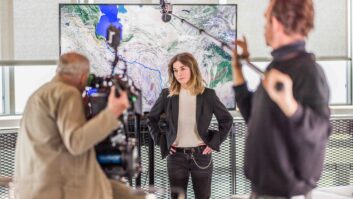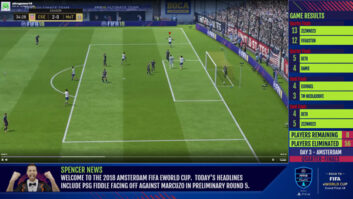For a TV series featuring dragons and ice zombies, you could be forgiven for thinking that Game of Thrones leans heavily on its groundbreaking visual effects, but the real secret to its global success could be the way its production team strives to make the fantastical as real as possible.
“I would always argue and will argue to my very last breath that if we can get it in camera it will be better,” said show production designer Deborah Riley.
She explained: “Because of the lighting conditions, the weather, the way the sun’s behaving on that day, the way they’re shooting it, the angles, everything about it is authentic and real and heavy. It has a reality to it. When the people are walking in front of something, they’re really walking in front of it.”
Riley, along with fellow production designer Rob Cameron and costume designer Michele Clapton, spoke at panel event at BAFTA, attended by TVBEurope, ahead of the production team’s special recognition at the British Academy Television Craft Awards.
“The great thing about our visual effects team is that they believe the same thing,” continued Riley. “They really want us to capture as much in camera as we possibly can, with the exception of the dragons, of course.”
That’s no joke, Riley explained, as “most of” the visual effects budget has to go towards making the dragons look as believable as possible.
“So, with the exception of some set extensions that we occasionally will have for an establishing shot, the vast, vast majority of what we do is in camera and I’m very proud of that.”
This ethos extends to show’s huge sets, some of which viewers might not have even realised were real constructions, rather than visual effects.
The Dragonstone audience chamber, which appeared for the first time last season as dragon queen Daenerys Targaryen finally returned home, was so vast that it took up half a stage in Belfast. It was built 35 feet high; meaning the majority of shots could be kept in camera.
Its centrepiece throne, which resembled the backbone of a dragon, was inspired by a rock strata seen during location scouting, with plasterers taking imprints to recreate its pattern exactly on set.
Daenerys’ homecoming was a significant event in the history of the show, so the set to which she returned “needed to be worth her journey,” said Riley.
But it’s not all about big spectacle, the finer details need to impress too. “It comes back to making it as real as possible for the actors and for the viewers, we go into all the details,” said production designer Rob Cameron. “We’ve got a great graphic department; when they’re doing the books, they do all the pages, the leatherwork and the binding.”
Cameron explained that the sets are always dressed in 360 degrees, keeping things flexible if a director changes their mind about the angle they want to shoot on the day and helping the performers buy in to the fantasy. “You want them to believe it,” he emphasised.
Maintaining that level of detail is not always easy, especially in a HDTV world. “High-definition TV changes everything, I think, for us,” said costume designer Michele Clapton. “Before, you could get away with things. Quality was very different, whereas now TVs are the size of a wall and you see everything – so everything has to be perfect.”
When it comes to costumes, she explained, everything has to look and feel authentic – as much as for the performer as the audience. “Every element has to work for that actor, so that when they put it on, they absolutely become that character.”
Adding to the challenge is that Game of Thrones has become a victim of its own success, to an extent, and as disparate storylines begin to tie together and characters meet, it creates an extra hurdle for the production team.
Riley explained: “Because of the increased demand for our cast, they have other shows that they’re doing at the same time, so their availability becomes less.
“As the seasons have gone on, we’ve got more characters in the same place, so they can’t cross-board them like they used to. When I first arrived it was much easier to separate them out, so it was much easier for the producers to be able to move the schedule accordingly. The problem is that now they’re all in the same place at the same time, you’re either shooting that or nothing at all.”
Musing on how set decorating for Game of Thrones isn’t all hanging banners and drapes, but more about mud and dummy dead bodies, Cameron highlighted another problem about working on one of the biggest TV shows in the world – keeping upcoming developments a secret.
“There’s dead horses, dead bodies and then this year we’ve got… other stuff” he quipped, stopping short of spilling any beans.
“Even in Dubrovnik, where King’s Landing was constructed and based, it got to the point where they couldn’t find enough hotel rooms for the crew because Dubrovnik had become so popular, because of Game of Thrones,” said Riley “I remember being in a scouting van and listening to the radio and they were saying that Game of Thrones had just left Mount Srd and are heading this way.
“From that point onwards we weren’t allowed to wear anything with the Game of Thrones logo on it, because we all had our crew jackets on. That was like season five. It’s got progressively more painful year after year. There was a time when we were allowed to print things out, that’s way over now.”

